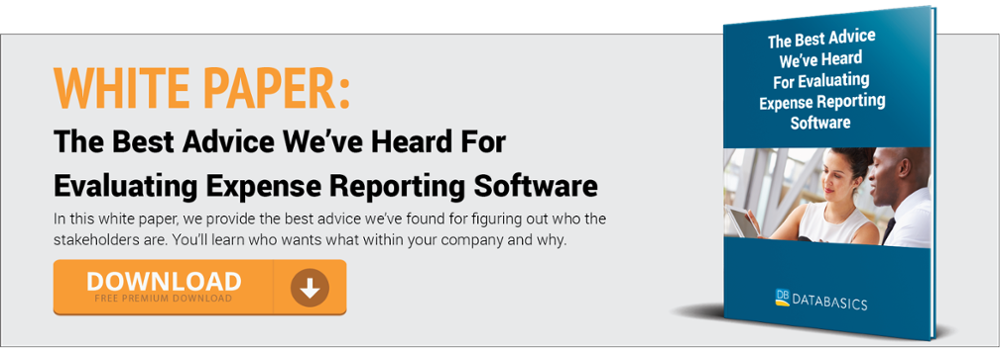
Six Signs You Need An Expense Reporting Makeover
Expense reporting solutions have made large advances in recent years. If you haven’t reviewed your expense reporting process lately you may be short-changing your employees, accounting team, and operational budgets!
Taking advantage of the latest in expense reporting by switching your service provider is an easy way to achieve organization-wide process improvements with little to no impact on budgets or resources.
There are six key indicators that your expense reporting process is under-performing:
- Your Company Is NOT Using Mobile Apps to Submit & Approve Expense Reports
- Your Accounting System and Expense Reporting System Are Out-Of-Sync
- You “Dumb-Down” Your Travel Policy for The Expense Reporting System
- You Don’t Really Know How Well Your Travel Policies Are Working
- Your Expense Tool Isn’t Integrated with Timesheets, Invoice Management, Travel, Etc.
- Your Company Has Decided When It Comes To Expense Reporting “Good Enough Is Good Enough”
#1: Your Company Is NOT Using Mobile Apps to Submit & Expense Reports
The easiest and fastest way for employees to report expenses is from their mobile devices. Utilizing a mobile app with OCR (Optical Character Recognition), employees can quickly take pictures of receipts, OCR automatically “reads” the receipt image and fills in fields, complete transaction details, and submit an expense report; all while on-the-go.
Companies can achieve cost savings,
as much as 67%, by automating
expense report processing.
MAnd for approvals, supervisors can now review and validate expense reports from anywhere and at any time.obile devices can easily display both transactions and receipts, then with 1-click, the approval process is completed. Literally, with a mobile app, the expense reporting process has become a snap (of your mobile phone’s camera)!
#2: Your Accounting System and Expense Reporting System Are Out-Of-Sync
Do you spend too much of your time chasing expense report filers with coding questions? Are you always making Expense journal entries? If the answer is yes, your expense report “solution” may be the problem! Basic to an effective expense reporting system is Automatic Accounting Integration.This integration should meet three key requirements:
-
It should work bi-directionally: Your expense system should import data in the same manner it extracts data. Vendor, project, and approval hierarchies should flow seamlessly into the system. Extracts to “target” modules like GL, AP, and Payroll should be error-free and require no manual intervention.
-
It should take care of all your code mapping: Data integration should be 100% mapped to the specifics of your organization. You shouldn’t accept extracts that are nothing more than large file dumps that have to be pre-processed (by you) prior to loading.
-
It should give YOU control of the frequency of data loads: Too often we hear administrators of other expense solutions say, “We get a feed X times a week from our provider.” Why let your provider control the frequency? You are the customer, you should control the frequency of your data imports and extracts!
Flawed or incomplete data integration can, by itself, undermine your expense management process. Compensating is labor-intensive and often produces disappointing results. The good news is that doing integration right is routine for some solution providers.
#3: You “Dumb-Down” Your Travel Policy for The Expense Reporting System
Effective travel policies need to take account of many challenging circumstances. Role and division may determine whether you can host a business dinner, how many participants are allowed, or even how much can be spent. How much you can pay for a hotel may depend upon the contract, meeting, or reason why you are about to spend company money and will need to submit an expense report. Unfortunately, many expense reporting systems don’t allow you to create rules with the precision you need. The result? Well, not good. Maybe with enough contortions you can rig the system to approximate at least some of your rules. More typically, you end up with a lot of bogus policy violation kick-outs with plenty of discord and confusion. And then, alternatively, automated policy enforcement may get scrapped altogether just to keep the peace. You shouldn’t have to compromise on your policies to accommodate your system provider’s programming deficiencies. Policy enforcement is fundamental to expense management. There are vendors who allow you to fine-tune your rules based on any combination of circumstances.
Related Article: How Level 3 Data Is Revolutionizing Expense Reporting
#4: You Don’t Really Know How Well Your Travel Policies Are Working
For many administrators of expense reporting systems, policy evaluation is more art than science. When you ask how effective their policies are, you may hear “We don’t get a lot of complaints,” or maybe even, “Our spend is in-line with last year.” What you don’t get are answers that reflect any specific objective analysis. The reason is not that their expense reporting system doesn’t produce good reports. All systems now have some way of data reporting. It’s that they don’t produce the right kind of reports. Moreover, they don’t allow someone who doesn’t have an advanced degree in computer science to identify and explore potential problem areas. Rules need to be refined based on on-going experience. If you can’t quantify that experience, then you really don’t have much to go on. It’s a fair bet that if your policy enforcement rules date back to when you first rolled-out your expense reporting system, it hasn’t been measured accurately since. What is needed is a feedback loop on your policies. Your expense system’s reporting should provide you with that capability and more!
#5: Your Expense Tool Isn’t Integrated with Timesheets, Invoice Management, and Travel
Indicator #2 covered data integration and how an effective expense solution will automatically integrate data bi-directionally and seamlessly. Once you have improved your data integration, it’s time to leverage that automation to maximize the full capability of the expense solution. Most companies use multiple systems to address different processes including timesheets, travel booking, and invoice workflow. An efficient solution should allow companies to integrate these processes to give the user a single point-of-entry and tackle numerous tasks at once. Timesheet integration allows companies to track total employee cost on projects as expenses and time worked can be combined, and invoice workflow builds upon existing approval and accounting processes. Next generation providers, like DATABASICS, deliver total efficiency with a single solution to optimize and streamline multiple processes. This gives the user quick and easy access, minimizes training (and headaches), and reduces IT costs from maintaining multiple systems.
#6: Your Company Has Decided When It Comes To Expense Reporting “Good Enough Is Good Enough”
No one may actually say it, but there are clear signs. Under the coaching from your current provider, you believe they’re “the only game in town.” Reports of poor service are discounted because it’s not that big a deal when the administrator is unhappy. IT and various people in finance have built whole favelas of spreadsheets and one-off programs to compensate for the system’s shortcomings. And distracting end-users with questionable conveniences or “trade-offs” is the major, if not, sole focus of process improvement. It doesn’t have to be this way. Effective expense management can yield substantial cost savings and is very important to an organization’s image and operational development. Companies that are perceived by their employees as tolerant of inefficient or even deficient processes, quite simply, lose their employees’ respect. That’s the price you should never pay.

DATABASICS provides cloud-based, next-generation Expense Reporting, P-Card Management, Timesheet & Leave Management, and Invoice Processing automation. Specializing in meeting the most rigorous requirements, DATABASICS offers the highest level of service to its customers around the world.
DATABASICS is relied upon by leading organizations representing all the major sectors of the global economy: financial services, healthcare, manufacturing, research, retail, engineering, non-profits/NGOs, technology, federal contractors, and other sectors.
Connect with DATABASICS: LinkedIn, Twitter, and YouTube. DATABASICS is headquartered in Reston, VA.
Subscribe to our blog
Recent Posts
Posts by Topics
- Expense Management Software (126)
- DATABASICS (69)
- Time Tracking Software (46)
- Leave Management System (26)
- P-Cards (9)
- Home Healthcare (8)
- Government Contractors (7)
- Nonprofit Organizations (7)
- International Development (6)
- Receipt Management (6)
- Advanced OCR (2)
- CROs (2)
- Staffing Agencies (2)
- Vendor Invoice Management (2)
- Audit Management Software (1)
- Construction (1)
- Field Service Management (1)
- Integration (1)
- Microsoft Dynamics (1)
- Oracle NetSuite (1)
- Partnerships (1)
- Professional Services (1)
Read on

Buyer’s Guide to Timesheet & Expense Reporting Software
Read Now
DATABASICS In Review: 2025's Top Innovations & Most Popular Content
Read Now
Time & Expense Year-End Preparation & New Year Kickoff To-Do List
Read Now
Combating AI-Generated Receipt Fraud with Spend Control
Read NowIRS Mileage Rate 2026 Predictions: Trends, History, EV Costs, and How Companies...
Read Now
DATABASICS Wins Silver In Best In Biz Awards 2025: Celebrating Excellence In...
Read Now
Subscribe to Our Blog
Subscribe to our blog and get the latest in time tracking and expense reporting news and updates.